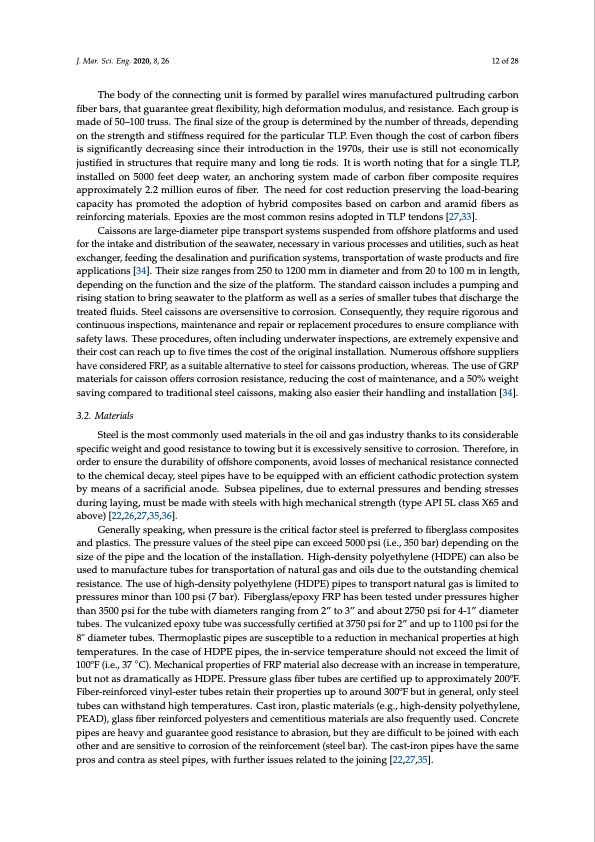
PDF Publication Title:
Text from PDF Page: 012
J. Mar. Sci. Eng. 2020, 8, 26 12 of 28 The body of the connecting unit is formed by parallel wires manufactured pultruding carbon fiber bars, that guarantee great flexibility, high deformation modulus, and resistance. Each group is made of 50–100 truss. The final size of the group is determined by the number of threads, depending on the strength and stiffness required for the particular TLP. Even though the cost of carbon fibers is significantly decreasing since their introduction in the 1970s, their use is still not economically justified in structures that require many and long tie rods. It is worth noting that for a single TLP, installed on 5000 feet deep water, an anchoring system made of carbon fiber composite requires approximately 2.2 million euros of fiber. The need for cost reduction preserving the load-bearing capacity has promoted the adoption of hybrid composites based on carbon and aramid fibers as reinforcing materials. Epoxies are the most common resins adopted in TLP tendons [27,33]. Caissons are large-diameter pipe transport systems suspended from offshore platforms and used for the intake and distribution of the seawater, necessary in various processes and utilities, such as heat exchanger, feeding the desalination and purification systems, transportation of waste products and fire applications [34]. Their size ranges from 250 to 1200 mm in diameter and from 20 to 100 m in length, depending on the function and the size of the platform. The standard caisson includes a pumping and rising station to bring seawater to the platform as well as a series of smaller tubes that discharge the treated fluids. Steel caissons are oversensitive to corrosion. Consequently, they require rigorous and continuous inspections, maintenance and repair or replacement procedures to ensure compliance with safety laws. These procedures, often including underwater inspections, are extremely expensive and their cost can reach up to five times the cost of the original installation. Numerous offshore suppliers have considered FRP, as a suitable alternative to steel for caissons production, whereas. The use of GRP materials for caisson offers corrosion resistance, reducing the cost of maintenance, and a 50% weight saving compared to traditional steel caissons, making also easier their handling and installation [34]. 3.2. Materials Steel is the most commonly used materials in the oil and gas industry thanks to its considerable specific weight and good resistance to towing but it is excessively sensitive to corrosion. Therefore, in order to ensure the durability of offshore components, avoid losses of mechanical resistance connected to the chemical decay, steel pipes have to be equipped with an efficient cathodic protection system by means of a sacrificial anode. Subsea pipelines, due to external pressures and bending stresses during laying, must be made with steels with high mechanical strength (type API 5L class X65 and above) [22,26,27,35,36]. Generally speaking, when pressure is the critical factor steel is preferred to fiberglass composites and plastics. The pressure values of the steel pipe can exceed 5000 psi (i.e., 350 bar) depending on the size of the pipe and the location of the installation. High-density polyethylene (HDPE) can also be used to manufacture tubes for transportation of natural gas and oils due to the outstanding chemical resistance. The use of high-density polyethylene (HDPE) pipes to transport natural gas is limited to pressures minor than 100 psi (7 bar). Fiberglass/epoxy FRP has been tested under pressures higher than 3500 psi for the tube with diameters ranging from 2” to 3” and about 2750 psi for 4-1” diameter tubes. The vulcanized epoxy tube was successfully certified at 3750 psi for 2” and up to 1100 psi for the 8" diameter tubes. Thermoplastic pipes are susceptible to a reduction in mechanical properties at high temperatures. In the case of HDPE pipes, the in-service temperature should not exceed the limit of 100oF (i.e., 37 ◦C). Mechanical properties of FRP material also decrease with an increase in temperature, but not as dramatically as HDPE. Pressure glass fiber tubes are certified up to approximately 200oF. Fiber-reinforced vinyl-ester tubes retain their properties up to around 300oF but in general, only steel tubes can withstand high temperatures. Cast iron, plastic materials (e.g., high-density polyethylene, PEAD), glass fiber reinforced polyesters and cementitious materials are also frequently used. Concrete pipes are heavy and guarantee good resistance to abrasion, but they are difficult to be joined with each other and are sensitive to corrosion of the reinforcement (steel bar). The cast-iron pipes have the same pros and contra as steel pipes, with further issues related to the joining [22,27,35].PDF Image | Marine Application of Fiber Reinforced Composites

PDF Search Title:
Marine Application of Fiber Reinforced CompositesOriginal File Name Searched:
jmse-08-00026.pdfDIY PDF Search: Google It | Yahoo | Bing
Development of a solar powered Electric Ship The Electricship website originally started off as a project to develop a comprehensive renewable, affordable, modular electric ship... More Info
Modular Boat Hull Composite The case for a unsinkable, modular composite hybrid boat hull... More Info
MS Burgenstock Hybrid Electric Catamaran Lake Lucerne Unique shuttle servicing Lucerne to the Burgenstock Resort... More Info
Ground Power Unit GPU Powered by Lithium Ion Batteries The goal of the Ground Power Unit is to provide a readily accessible, modular, ready-to-power solution for remote power... More Info
| CONTACT TEL: 608-238-6001 Email: greg@electricship.com | RSS | AMP |